How does a bladeless fan work: design and principle of operation of the device
One of the new products on the climate equipment market is a bladeless fan.The device simultaneously arouses interest and doubt among potential buyers. This unusual bladeless fan surprises with its appearance and functionality.
Some people decide to purchase it, while others worry that the money will be wasted. To dispel doubts about the performance of the equipment, you need to take a closer look at its structure, operating principle and operating features.
The content of the article:
A few words about creating a bladeless fan
A model that is radically different in appearance from others types of fans, familiar to many since childhood, was invented in 2009. Its creator is James Dyson.
He worked for about 30 years on options for improving the vacuum cleaner and other household and industrial equipment. This English developer came up with many interesting and useful inventions, the patents for which were sold to different countries around the world.

All of his developments are distinguished by exquisite design and improved functionality.Mr. Dyson, working to improve the hygienic hand dryer, took the principle of its operation as a basis for his new invention. So, in 2009, a special fan appeared that did not have blades.
J. Dyson's leading engineers spent about 4 years simulating a fan ring that could most effectively pass air through itself, multiplying it many times over.
Already in 2010, a bladeless device from Dyson was sold in the inventor’s homeland for 199 British pounds. This price can hardly be called popular, but there were many who wanted to acquire an innovative fan.
Therefore, now on the market you can find similar equipment from various manufacturers, including budget Chinese models.
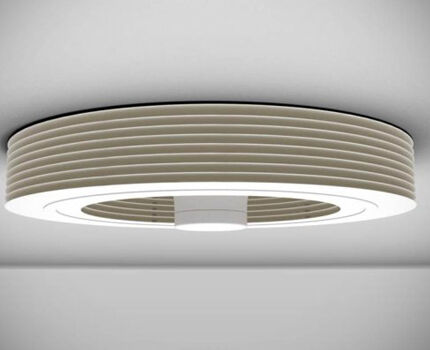
Design and operation of a bladeless device
A fan without blades is often called a Dyson fan in honor of its creator or, as he himself called the device, an Air Multiplier. This original invention is in demand due to its ability to create a uniform air flow and fit perfectly into any interior.
The multiplier looks stylish, and the presence of analogues on the market makes it accessible to a wide range of consumers.
Structural components of the air multiplier
The Dyson air multiplier is capable of multiplying the air flow at the outlet. Moreover, the company’s engineers, designers and technologists create more advanced models that can not only blow on objects, furniture and people in the room, but also perform functions air purification and humidification.
However, the price of such new products exceeds $300.
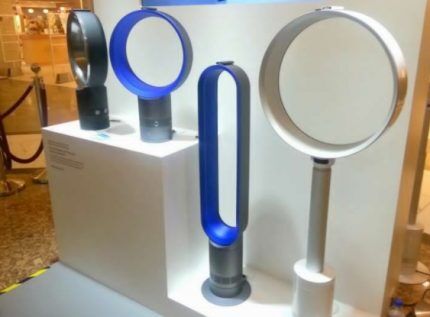
Depending on the model, the device itself will differ. After all, the more functions it can perform, the more buttons there will be on the control panel.
A fan without blades consists of the following parts:
- frame;
- control Panel;
- blower
The housing contains a motor that is responsible for the operation of the device. There are also special holes on this part through which air will be drawn in when the multiplier is turned on.

The fan can be controlled mechanically or electronically using a panel.In most cases, remote control is provided. Many models from various manufacturers are equipped with a remote control that operates, on average, at a distance of 3 meters.
The control panel provides:
- on/off button;
- rheostat for adjusting the speed of operation;
- other buttons depending on the multiplier model and the functions provided by the manufacturer.
The blower has a round or oval shape. Its size depends entirely on the model of the product. This part of the fan can have a clear geometric shape or be in the shape of a heart, apple, etc.

Air multipliers can be divided into 3 types based on installation method:
- floor;
- desktop;
- wall-mounted
The first 2 types refer to portable devices, and the last one to stationary devices. Manufacturers often provide two options for one model: wall mounting and table mounting. In this case, the fan must be equipped with brackets and dowels.

Dyson fan: operating principle
Bladeless fans are capable of passing through up to 500 liters of air in 1 second. The outlet flow is evenly distributed, gently enveloping the entire space. During a visual inspection, no moving parts are observed outside the operating device. This is exactly what an air multiplier looks like at first glance.
The principle of such efficient operation of a bladeless fan is the multiple multiplication of drawn-in air at the outlet.This occurs due to the special shape of the blower and the presence of a specially shaped hollow channel inside it.
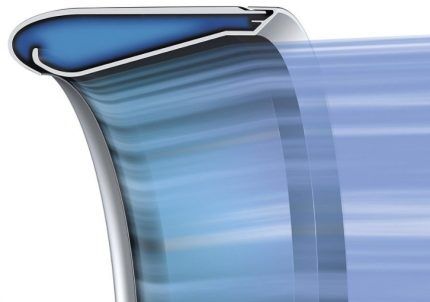
First, a high-speed motor draws air through small holes at the base of the device. This air then moves into the blower channel. The channel shape is designed on the same principle as an airplane wing. Therefore, when air moves inside the channel, its speed increases.
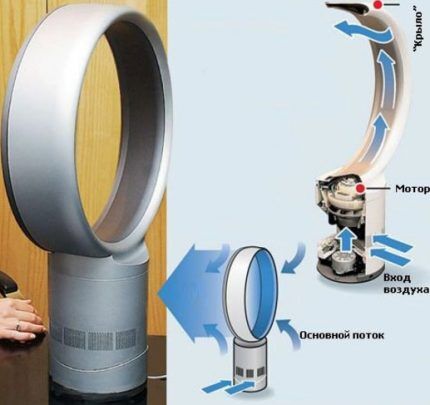
Air exits the channel from the narrower side, and a low pressure area is formed on the opposite side. This ensures that air is actively drawn in, the volume of which is 15-20 times greater than the original drawn in by the engine.
As a result, people in the operating area of the device are blown much stronger than when using a conventional blade fan.
Features of using a multiplier
The scope of use of a fan without blades is very wide - in a home, office, cottage, kindergarten, hospital or other municipal institution. The exception is bathrooms, premises with a swimming pool, saunas, baths. There it is important to ensure effective removal of wet vapors.
The fact is that the device is safe if it is used by capable members of society. Otherwise, use is permitted under adult supervision.

In addition to the gentle distribution of multiply increased air flow, a fan without blades can humidify the air and cool/heat. The user sets the humidity percentage in the settings. The adjustment range depends on the model of the device and ranges, on average, from 30 to 70%.
As for the heating or cooling function, it is available in more expensive models. The desired parameters are specified by the user. You can also choose a model that can purify the air from harmful impurities, for example, smoke or fumes.
The climate control equipment market is replete with offers of various models of bladeless fans from many manufacturers. Among them are both affordable models costing up to $100, as well as expensive options from well-known brands with the functions of real air conditioner or split system.
Among the manufacturers offering their bladeless equipment are the following companies: Flextron, SUPRA (Supra), UNISVET, Clever and Clean, Roward, Dyson, Coolguy, Aaron, RENOVA, Orion, Bladeless, BiLux, MAGNIT.
The price range of bladeless devices from these companies is from 2,000 to 35,000 rubles or more.
An important characteristic that affects the level of comfort when using a fan is the noise level. It can be 40 dB, 55 dB, 60 dB or more. This is the most important parameter that should be taken into account before purchasing.
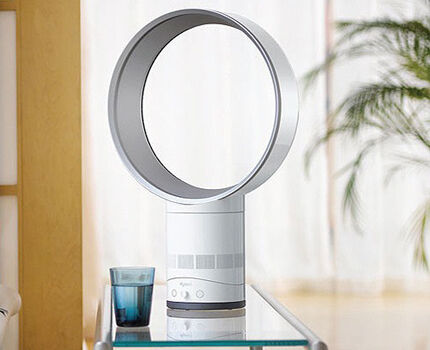
Manufacturers indicate the noise level of a specific model in the technical specifications.Moreover, this is the maximum level that is achieved when the equipment operates at maximum speed. For cheap devices, the declared noise level may not correspond to reality.
Pros and cons of bladeless fans
The air multiplier has its advantages and disadvantages identified by users.
Among the positive aspects are:
- safety;
- uniform air flow;
- minimal electricity consumption;
- convenient control;
- ease of care;
- stylish design.
Safety is ensured by the absence of blades and other moving parts outside the product. Also, thanks to the motor located below and the absence of vibration from the rotation of the blades, the entire structure turned out to be stable.

Electricity consumption is most often 25 W and 40 W. Models with other characteristics are less common.
Operating the device is simple and straightforward. All the details of adjusting the purchased model are described in detail in the instructions. The air flow power of a bladeless fan is also adjustable.
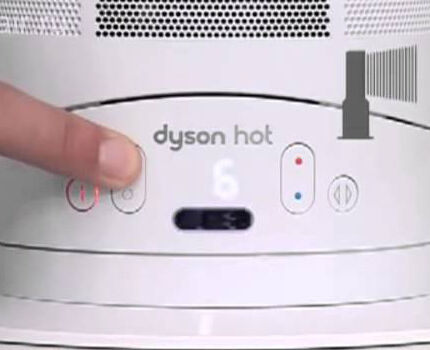
In addition to the advantages, the bladeless device has its disadvantages:
- Noise effect — sound level from 40 dB. The larger and more powerful the device, the louder it will buzz at maximum speed.
- High price. The equipment is inferior in this indicator to conventional blade fans.
- Fragility of the structure. This drawback is typical for inexpensive Chinese-made analogues.
Manufacturers strive to take into account all the shortcomings and wishes of customers, improving new fan variations. So, first, consumers were offered various colors and sizes, then - the most intricate shape. Later it was time to reduce the noise level produced by the device as much as possible.
The next task was to reduce energy consumption and add additional functions for humidification and heating/cooling the air passing through the bladeless fan.
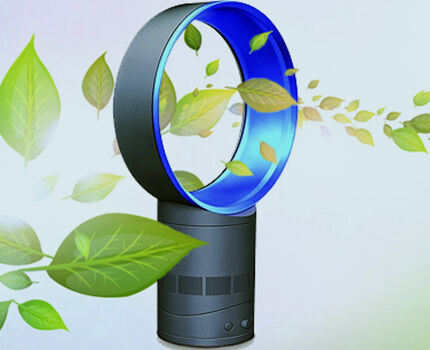
DIY bladeless device
The question of creating a fan without blades with your own hands has visited many craftsmen. During the experiments, home craftsmen obtained many working homemade products.
Option #1: product made from plastic buckets
To make the device, use a plastic container, a simple fan and a glue gun.
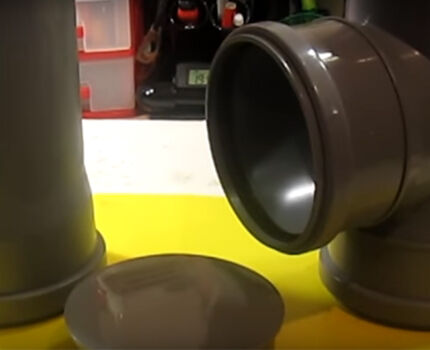
For example, you can take:
- 2 plastic buckets with a volume of 5 and 10 liters;
- PVC pipe 110;
- distribution tee;
- stub.
First, you need to cut a piece 15 cm long from the pipe. Then, in a 10-liter bucket, make a hole on the side exactly the same size as the outer diameter of the pipe.
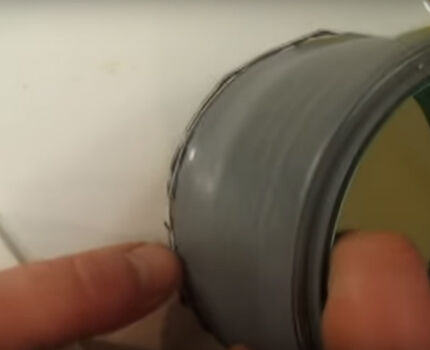
The next step is to take a 5 liter bucket and cut 3 cm from the top edge. We still have to cut a hole in the bottom, the diameter of which is 2 cm smaller than the bottom of the bucket itself.You also need to make a hole of the same size in the bottom of the larger bucket and connect them together with a glue gun. This is a homemade blower.
Now we have to assemble a housing with a motor, the role of which will be played by an axial fan. To do this, put the plug on the side pipe of the tee, having previously applied an adhesive layer there.
It is better to leave a small gap of 1.5-2 cm to allow air access. Then you need to put the PVC pipe on one of the tee pipes and mark the boundary - this will be a segment of about 10 cm that needs to be cut.

It is here that an axial electric fan of the required diameter will be installed, and a wire will be brought out into the hole to be connected to the electrical network.
To give the finished homemade product an aesthetic appearance, all parts can be painted in one color with spray enamel. For example, in white, beige or blue. The case is ready to connect to the network.
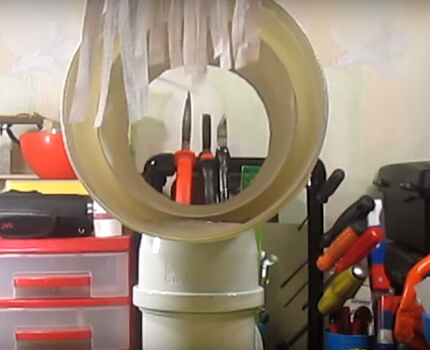
If you place a container with ice inside the case, the homemade product will act as an air conditioner. And by placing a piece of cotton wool with 5-7 drops of essential oil, you can fill the entire room with a pleasant aroma.
Option #2: fan made of plastic pipes
The prototype of the second option was a bladeless device of the brand Dyson. The body and technical part were assembled by a home craftsman according to the scheme of a finished factory-produced product.
Let’s start building a homemade product useful in everyday life with the body:
The case is ready, now it should be equipped with technical stuffing:
The assembly of the device is almost complete. All that remains is to cut and glue the bottom to the base of the stand. And it’s better to glue four round flat legs to the bottom, cut from a piece of rubber 4-5 mm thick.
Original ideas for creating a household fan are presented in this article.
Care and maintenance of the device
A fan without blades can last the period stated by the manufacturer in the instructions only if the rules of its operation are followed. It is easy to use and maintain. It is important to use the device for its intended purpose and not to move it from place to place during operation.
If you need to rearrange the equipment, then you should grab it by the body, and not by the blower.
To maintain the air multiplier, it is enough to periodically perform the following actions:
- clean the blower holes with a brush to prevent them from clogging;
- Wipe the blower and the device body with a damp cloth, removing dust and other contaminants.
Maintenance should be performed as needed. There is no need to use special cleaning agents or detergents - the surface of bladeless fans can be easily cleaned with a damp or dry soft cloth.

If a malfunction is discovered, you should contact specialists authorized to repair climate control equipment from a specific manufacturer.
Attempting to fix the problem yourself may void the warranty on the fan. If you lack experience in repairing such devices, you can cause even more damage to the equipment.
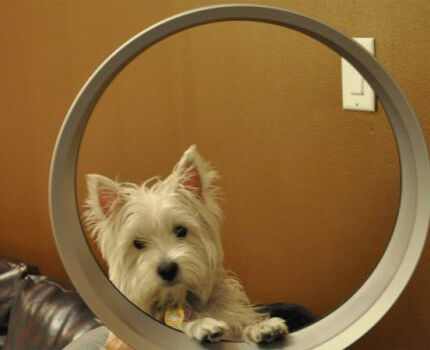
Conclusions and useful video on the topic
About the design and operating principle of an improved model of a bladeless fan from Dyson in a video review:
The advantages of bladeless fans are discussed in the video:
You can see how to assemble a fan without blades from scrap materials in the following video:
A fan without blades can be made from scratch, spending a minimum of effort and materials. Step-by-step assembly instructions in the video:
Having examined the features of the design and operation of a bladeless fan, and familiarized yourself with the model range of various manufacturers, you can form your own opinion about the device. Products from well-known companies are not cheap, but they are quite capable of replacing air conditioning.
Cheaper analogues make loud noise, squeak and may not provide the performance indicated in the instructions.
Do you have experience using a bladeless fan? Or maybe you managed to assemble the unit yourself? Please share information with our readers. Leave comments and ask questions on the topic in the form below.
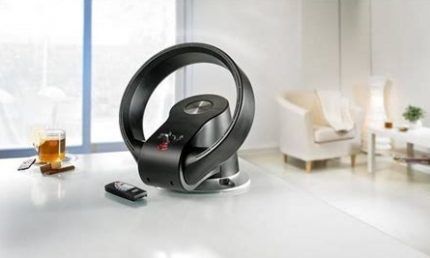




So far I have not seen such a fan among my acquaintances and friends, apparently due to its high cost. It is hardly worth buying Chinese counterfeits, because they will not last long, and the effect of their use will not be what you expect from quality products. I would like to note that such a fan will be useful for families with small children, otherwise they will stick their fingers everywhere.
Not everything made in China is of poor quality. Don’t forget that China is now a global assembly shop, where many global brands assemble their equipment. Yes, with the current US policy this may change soon, but for now we have what we have.
Well, if you don’t like the Chinese at all, then look at the domestic manufacturer - Kitfort. Or the market leaders - Dyson, but their prices are steep.
We bought it more as a cute decorative accessory, but it turned out to be very popular.If you have a small child and curious pets, a bladeless fan in the summer is ideal! It's certainly not cheap, but it's much more affordable than installing an air conditioner. In addition, it requires virtually no maintenance, you just need to wipe it with a cloth periodically. If you like unusual gadgets for your home, go for it!
Question about the video about self-assembly of such a fan. The author calls the power supply an adapter. Can the device work with such a power supply without a network? If so, what time?